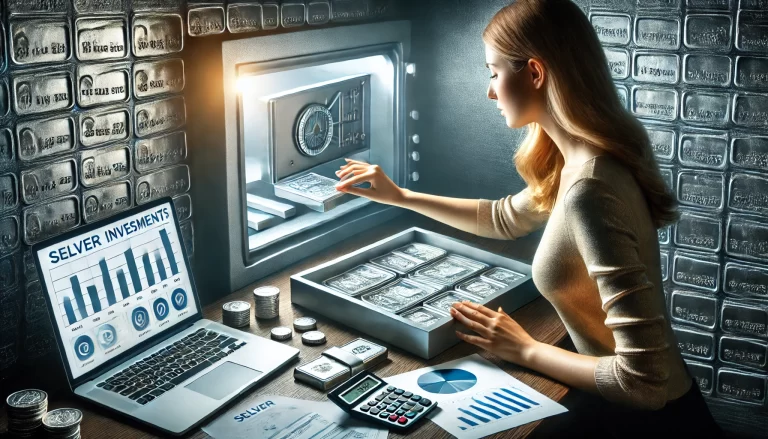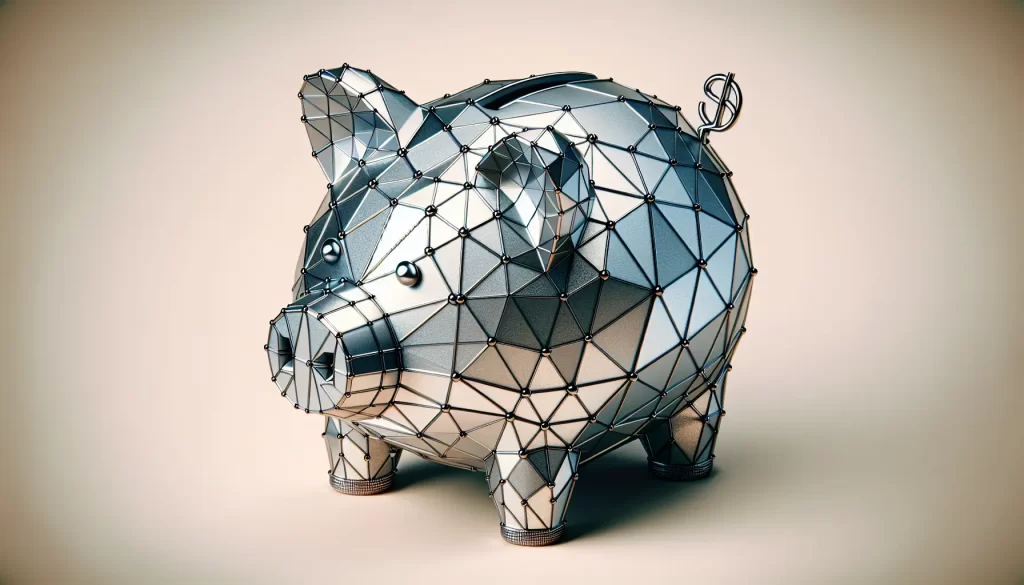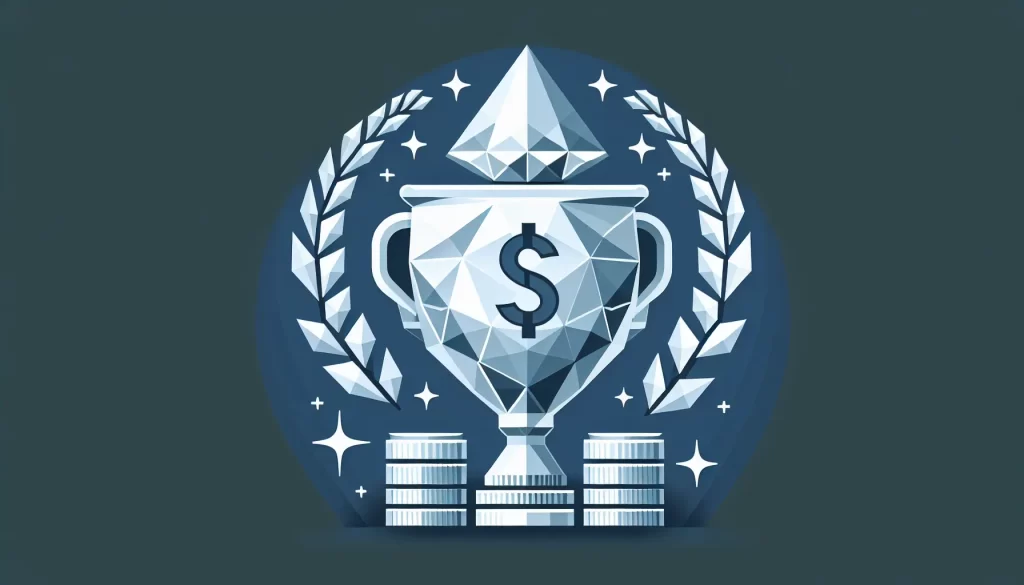In this article we are going to cover everything you want to know about Silver IRAs.
If you plan to read this entire article, plan to spend around 11 minutes to do so.
We’ll cover everything from what a silver IRA is, to the distinct benefits compared to other precious metals, and some of the fees associated with having one.
Quick Disclaimer:
The content provided in this article is for informational purposes only and should not be considered financial or investment advice. Always consult with a qualified financial advisor before making any decisions regarding Precious Metals, Investing, or IRAs. Additionally, this article contains affiliate links, and I may earn a commission if you make a purchase through these links, at no additional cost to you.
Augusta Precious Metals Links:
What is a Silver IRA?
A Silver IRA is a specialized retirement account that invests in silver bullion and other precious metals instead of traditional assets like stocks and bonds.
It allows you to diversify your retirement portfolio by adding physical silver to your investment mix.
Silver IRAs are subject to specific regulations set by the IRS, including the requirement that the silver must be 99.9% pure (CBS News).
Here’s a breakdown of key features of a Silver IRA:
| Feature | Description |
|---|---|
| Type of Investment | Physical silver bullion and coins |
| Purity Requirement | 99.9% pure silver |
| Regulatory Body | IRS |
| Account Type | Self-directed IRA |
Benefits of Investing in Silver
Investing in a Silver IRA offers several advantages, especially when you are looking to diversify your wealth and hedge against economic uncertainties.
- Hedge Against Inflation: Silver is historically seen as a hedge against inflation. When the value of the dollar decreases, the value of silver typically remains stable or increases, protecting your purchasing power.
- Safe Haven Asset: During times of economic uncertainty, silver is considered a safe haven investment, similar to gold. It retains its value better than paper currency and other assets, making it a reliable option during market volatility (Scottsdale Bullion & Coin).
- Diversification: A Silver IRA provides diversification for your investment portfolio. By holding physical silver, you spread out your risk and reduce dependence on traditional financial markets.
- Potential for Growth: Silver prices can be influenced by various factors, including industrial demand and geopolitical events, offering potential for growth. For more insights, visit our silver price forecast.
While there are significant benefits, it is also essential to understand the risks involved. Silver prices can be volatile, and the value can be influenced by industrial applications and economic cycles.
It’s crucial to conduct thorough research and due diligence before investing. For more tips, check out our guide on how to invest in silver.

How to Open a Silver IRA Account
Before we look at some potential custodians, and some of the limits and rules, I wanted to cover how to open/set up a silver IRA.
Thankfully, opening a Silver IRA involves a few straightforward steps.
- Choose a Custodian: The first step is selecting a custodian. Custodians are financial institutions that manage your Silver IRA and ensure compliance with IRS regulations. We’ll cover how to choose the right custodian in the next section.
- Open an Account: Once you have selected a custodian, you will need to open an IRA account with them. This usually involves filling out an application form and providing identification documents.
- Fund Your Account: After opening the account, you will need to fund it. This can be done through a rollover from an existing retirement account or by making a direct contribution. Be mindful of the annual contribution limits.
- Select Your Investments: The next step is to choose the silver bullion or other precious metals you want to invest in. The IRS requires that the silver meet specific purity standards, with silver needing to be 99.9% pure to qualify.
- Purchase and Storage: Finally, your custodian will purchase the silver on your behalf and arrange for its storage in an approved depository.
Choosing a Custodian
Choosing the right custodian for your Silver IRA is crucial.
I have several different articles on how to choose a custodian, but I wanted to summarize here.
Custodians are responsible for the administration of your account and ensuring compliance with IRS regulations. Here are some factors to consider when selecting a custodian:
- Reputation and Experience: Look for a custodian with a strong reputation and extensive experience in managing precious metal IRAs. Check reviews and ratings from other investors.
- Fees: Precious metal IRAs often come with higher fees than traditional IRAs. These can include setup fees, transaction fees, custodial fees, and storage fees (Forbes). Make sure to compare the fee structures of different custodians.
- Storage Options: Ensure that the custodian offers secure storage options for your silver. The silver must be stored in an IRS-approved depository to maintain its tax-advantaged status.
- Customer Service: Good customer service is essential. You want a custodian who is responsive and can provide clear answers to your questions.
- Compliance: Verify that the custodian complies with IRS regulations. The IRS allows approved nonbank organizations to act as trustees for nontraditional IRA assets (Journal of Accountancy).
| Custodian Factor | Importance |
|---|---|
| Reputation and Experience | High |
| Fees | High |
| Storage Options | Medium |
| Customer Service | High |
| Compliance | High |
Setting up a Silver IRA can be a great way to diversify your retirement portfolio.
By carefully choosing a custodian and understanding the steps involved, you can ensure that your investments are secure and compliant with IRS regulations.
For more information on investing in silver, check out our articles on silver etfs and best silver investments.
Another common question I get asked about sales tactics used by Gold IRA companies is about how silver is leveraged and mentioned.
If you want to learn more, below are two free PDFs by Augusta Precious Metals that break down how to check the integrity of an IRA provider as well as information on how Silver is used as a sales tactic.
Augusta Precious Metals Links:
Contribution Limits and Rules
When considering a Silver IRA, it’s essential to understand the contribution limits and what you can invest in.
This knowledge will help you make informed decisions and maximize your investment potential.
Annual Contribution Limits
For 2023, the annual contribution limit for both traditional and Roth IRAs, including self-directed IRAs like a Silver IRA, is $6,500.
For individuals aged 50 and over, there’s an additional catch-up contribution of $1,000, making the total $7,500. In 2024, these limits rise to $7,000, and $8,000 for those aged 50 and above.
| Year | Under 50 | 50 and Over (Catch-Up) |
|---|---|---|
| 2023 | $6,500 | $7,500 |
| 2024 | $7,000 | $8,000 |
What You Can Invest In
A Silver IRA allows you to invest in silver bullion and other precious metals instead of traditional assets like stocks and bonds. However, the IRS has specific rules regarding what types of silver can be included in your IRA.
Approved Silver Investments
To qualify for a Silver IRA, silver must meet specific purity standards. The silver needs to be at least 99.9% pure to ensure its investment value is protected (CBS News). Here are some examples of approved silver investments:
- American Eagle coins
- Canadian Maple Leaf coins
- Australian Koala bullion coins
- PAMP Suisse bars
Prohibited Silver Investments
Not all silver items are eligible for a Silver IRA.
For instance, collectible silver coins are considered collectibles and are prohibited investments for self-directed IRAs.
For more detailed information on the types of silver you can invest in, check out our guide on best silver investments.
For further insights into diversifying your portfolio with silver, visit our article on investing in silver.
Benefits and Risks
Diversifying Your Portfolio
Investing in a Silver IRA can offer significant benefits, particularly when it comes to diversifying your portfolio.
By including silver in your retirement savings, you can potentially reduce the overall risk of your investments.
Precious metals like silver often move independently of traditional assets such as stocks and bonds, providing a hedge against market volatility.
Incorporating silver into your investment strategy can also serve as a safeguard against inflation. Precious metals tend to retain their value over time, making them a reliable store of wealth during economic downturns.
This can be particularly beneficial if you are looking to protect your retirement savings from the erosive effects of inflation.
Most experts recommend allocating no more than 5% to 10% of your retirement funds to precious metals within a Self-Directed IRA.
This ensures that you maintain a diversified portfolio while minimizing unnecessary risk.
| Investment Type | Recommended Allocation (%) |
|---|---|
| Stocks | 50 – 60 |
| Bonds | 20 – 30 |
| Real Estate | 10 – 15 |
| Precious Metals (Silver, Gold) | 5 – 10 |
Potential Risks
While there are clear advantages to investing in a Silver IRA, it’s also important to be aware of the potential risks involved.
One of the primary risks is market volatility. The value of silver can fluctuate significantly due to its industrial applications and economic cycles (CBS News).
This means that while silver can provide a hedge during certain market conditions, its price can also be unpredictable.
Another risk to consider is the possibility of dealing with unreputable dealers.
In some cases, dealers may overcharge for their services or sell overpriced silver.
This can erode the value of your investment and reduce your potential returns.
To mitigate this risk, it’s essential to conduct thorough research and due diligence before selecting a dealer or custodian for your Silver IRA.
Additionally, Self-Directed IRAs, including Silver IRAs, often come with higher fees compared to traditional IRAs.
These fees can include account setup fees, annual maintenance fees, storage fees, and transaction fees.
It’s important to carefully consider these costs and how they may impact your overall investment strategy.
To learn more about how to invest in silver and the best strategies for managing these risks, check out our articles on how to invest in silver and investing in silver.
By staying informed and making well-researched decisions, you can maximize the benefits of your Silver IRA while minimizing potential drawbacks.
Factors Affecting Silver Prices
Understanding the factors that influence silver prices is crucial for making informed investment decisions.
Here, we’ll explore two main elements: market demand and economic influences.
Market Demand
The demand for silver is driven by both industrial and investment sectors.
Industrial demand is expected to rise significantly, with a projected 46% increase between 2023 and 2033.
Silver is utilized in various industries including:
- Water Purifiers
- Medicinal Treatments
- Automotive Applications
- Solar Cells
| Industry | Projected Demand Increase (2023-2033) |
|---|---|
| Water Purifiers | 20% |
| Medicinal Treatments | 15% |
| Automotive Applications | 30% |
| Solar Cells | 50% |
The industrial applications of silver contribute to its steady demand, which can support price increases.
Additionally, silver is considered a safe haven investment, much like gold, especially during economic uncertainty.
This perception can lead to significant upward pressure on prices during economic crises.
Economic Influences
Several economic factors can affect silver prices, including the performance of the U.S. dollar, inflation, and government policies.
- U.S. Dollar: The price of silver generally has an inverse relationship with the U.S. dollar. A strong dollar can create downward pressure on silver prices, while a weaker dollar can push prices up. Savvy investors may look for times when the dollar is strong to find bargain prices for their silver purchases.
- Inflation: Silver is historically seen as a hedge against inflation. During periods of high inflation, the value of paper currency erodes, but silver retains its value better, providing protection against losses in purchasing power (Scottsdale Bullion & Coin).
- Government Actions: Government policies and actions, such as central banks buying and selling silver bullion, also influence the market. National mints, like the U.S. Mint, consume a significant portion of the world’s silver supply by producing bullion and numismatic-quality coinage.
- For more insights on how these factors play out in the real world, read our article on silver price manipulation.
- For further reading, check out our guide on how to invest in silver and explore the best silver investments for diversifying your portfolio.
Tips for Investing in Silver
Investing in a Silver IRA can be a smart way to diversify your portfolio and protect your wealth.
However, it’s important to approach this investment with careful planning and knowledge. Here are some essential tips to help you make informed decisions.
Research and Due Diligence
Before diving into silver investments, thorough research and due diligence are crucial. Regularly check the silver price forecast to stay updated on market predictions.
- Study Historical Trends: Look at historical data to understand how silver prices have behaved in different economic conditions. This can help you predict future movements.
- Monitor Market Demand: Keep an eye on the industrial demand for silver, as it is widely used in electronics, solar panels, and medical instruments.
- Understand Economic Influences: Factors like inflation, currency devaluation, and geopolitical events can impact silver prices. Learn how these elements affect the market.
- Check Reputable Sources: Use reliable sources for information. Websites like Forbes and CBS News offer trustworthy insights.
Avoiding Common Pitfalls
Investing in a Silver IRA comes with its own set of risks. Being aware of these common pitfalls can help you avoid costly mistakes.
Beware of High Fees: Precious metal IRAs often involve higher fees than traditional IRAs. Setup fees, transaction fees, custodial fees, and storage fees can add up. Make sure to understand all associated costs before investing.
| Fee Type |
|---|
| Average Cost |
|---|
| Setup Fees |
|---|
| $50 – $250 |
|---|
| Transaction Fees |
|---|
| $40 – $100 |
|---|
| Custodial Fees |
|---|
| $75 – $300 |
|---|
| Storage Fees |
|---|
| $100 – $300 |
|---|
Limit Your Investment: Most experts recommend investing no more than 5% to 10% of your retirement funds in precious metals. This helps maintain a diversified portfolio and minimizes risk.
Avoid Unreputable Dealers: Be cautious of dealers who overcharge for their services or sell counterfeit silver. Always verify the credibility of the dealer before making a purchase.
Understand the Risks: Silver prices can be volatile and influenced by industrial demand and economic cycles. Be prepared for fluctuations and invest with a long-term perspective.
Use Approved Investments: Ensure that the silver you invest in meets the IRS requirements for purity and form. Typically, this includes silver bars and coins with a fineness of 0.999 or higher.
For more strategies on investing in silver, visit our section on how to invest in silver.
For additional guidance, check out our articles on silver etfs and investing in silver stocks.



